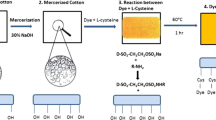Abstract
Acrylic fabric was treated with direct dyes in combination with copper and zinc sulfates as mordanting agents and then tested for their antimicrobial activity against Gram-positive and Gram-negative bacteria. The metal salts used were also studied for their likely effects on the antimicrobial property of fabrics dyed with C.I. Direct Yellow 12, C.I. Direct Red 23, C.I. Direct Red 31, and C.I. Direct Black 38. Untreated (control) acrylic fabric exhibited no antibacterial behavior whilst dyed and mordanted fabrics revealed considerable antimicrobial properties. It was found that the fabric treated with C.I. Direct Yellow 12 and copper sulfate as mordant achieved the highest antimicrobial activity with good washing fastness. Finally, FT-IR analysis, light, and washing fastnesses of the treated samples were evaluated.
Similar content being viewed by others
References
G. Sun, X. Xu, J. R. Bickett, and J. F. Williams, Ind. Eng. Chem. Res., 40, 1016 (2001).
Y. H. Kim and G. Sun, Text. Res. J., 71, 318 (2001).
T. Nakashima, Y. Sakagami, H. Ito, and M. Matsuo, Text. Res. J., 71, 688 (2001).
S. Han and Y. Yang, Dyes Pigm., 64, 157 (2005).
M. Orhan, D. Kut, and C. Gunesoglu, Indian J. Fiber Text. Res., 32, 114 (2005).
S. Rahbaran, Chem. Fibers Int., 49, 491(1999).
S. H. Lim and S. M. Hudson, Carbohydr. Polym., 56, 227 (2004).
N. L. Lala, R. Ramaseshan, L. Bojun, S. Sundarrajan, R. S. Barhate, L. Ying-jun, and S. Ramakrishna, Biotechnol. Bioeng., 97, 1357 (2007).
D. Abedi, S. M. Mortazavi, M. Khajeh Mehrizi, and M. Fiez, Text. Res. J., 78, 311 (2008).
T. Zhao and G. Sun, J. Appl. Polym. Sci., 106, 2634 (2007).
D. Gupta and A. Laho, Indian J. Fiber Text. Res., 32, 88 (2007).
Y. Sawa and M. Hoten, Sen’i Gakkaishi, 57, 153 (2001).
Zaisheng Cai and G. Sun, J. Appl. Polym. Sci., 97, 1227 (2005).
United State Pharmacopeia (USP) 23, “Biological Tests/Microbial Assays” (81), p.1691, 1995.
Y. A. Son and G. Sun, J. Appl. Polym. Sci., 90, 2194 (2003).
S. Baseri, A. Zadhoush, M. Morshed, M. Amirnasr, and M. Azarnasab, J. Appl. Polym. Sci., 104, 2579 (2007).
M. Ma and G. Sun, Dyes Pigm., 66, 33 (2005).
R. M. EL-Shishtawy and N. S. E. Ahmad, Color. Technol., 121, 139 (2005).
G. Moroi, D. Bilba, N. Bilba, and C. Ciobanu, Polym. Degrad. Stab., 91, 535 (2006).
Author information
Authors and Affiliations
Corresponding author
Rights and permissions
About this article
Cite this article
Khajeh Mehrizi, M., Mortazavi, S.M. & Abedi, D. The antimicrobial characteristic study of acrylic fiber treated with metal salts and direct dyes. Fibers Polym 10, 601–605 (2009). https://doi.org/10.1007/s12221-010-0601-z
Received:
Revised:
Accepted:
Published:
Issue Date:
DOI: https://doi.org/10.1007/s12221-010-0601-z



